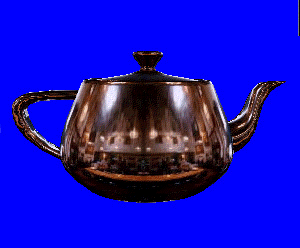
| Microsoft DirectX 8.1 (Visual Basic) |
Environment mapping is a technique that simulates highly reflective surfaces without using ray tracing. In practice, environment mapping applies a special texture map that contains an image of the scene surrounding an object to the object itself. The result approximates the appearance of a reflective surface, close enough to fool the eye, without incurring any of the expensive computations involved in ray tracing.
The following image is taken from the C++ SphereMap Sample, which, as its name implies, uses a type of environment mapping called spherical environment mapping. For details, see Spherical Environment Mapping.

The teapot in this image appears to reflect its surroundings; this is actually a texture being applied to the object. Because environment mapping uses a texture, combined with specially computed texture coordinates, it can be performed in real-time.
This section provides information about performing two common types of environment mapping with Microsoft® Direct3D®. There are many types of environment mapping in use throughout the graphics industry, but the following topics target the two most common forms: cubic environment mapping and spherical environment mapping.